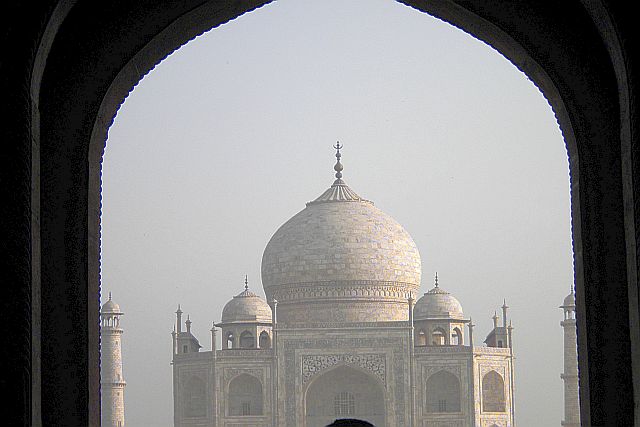 |
| The Taj Mahal is hidden by an arch that reveals the building as you enter (Taylor) |
Listed as one of the seven
wonders of the modern world, the Taj Mahal is also one of India’s most precious
tourist attractions, if not THE most recognized site in the country. Sadly, the
Taj, which was completed in 1643 as a tribute by Mughal Emperor Shah Jahan as
an eternal tribute of his undying love for his wife Mumtaz Mahal, is today fighting
a losing battle against pollution.
Over the centuries the Taj
Mahal has survived multiple threats including Mogul rule and British
colonialism, but now environmentalists must find a way to halt the enslaught of
contemporary pollution.
Pollution problems have
plagued the ancient mausoleum for decades, but the efforts to resolve the
situation have resulted in a Catch-22 that will require a new approach to save
the giant marble monument before it disappears.
 |
| Erosion is beginning to take its toll (wikipedia) |
Situated on the south bank of
the Yamuna River, the Taj has been battling deterioration problems resulting
from nearby industries since the early days of the 20th century. Despite a 1983
law which banned industrial construction within a 50-square mile radius of the
monument, more than 200 new factories have been built in recent years.
Sulphur dioxide emitted from
factories near the Taj Mahal was the primary culprit at first, but with nearly
7-million visitors to the site each year, exhaust from trucks and buses has also
contributed to the problem.
At first the solution was to
wash the mausoleum on a daily basis in an effort to eliminate as much of the
polluting agents as possible.
Over time however, the Yamuna
River has also become a victim making it little more than a liquid garbage
dump. In the process, the fish have long since disappeared, leaving swarms of
insects to thrive and endanger the Taj even further.
 |
| The symmetry of the mausoleum is one of its appealing features (wikipedia) |
Today the soft marble
structure is visibly eroding with yellow and brown spots that can be seen with
the naked eye.
The daily chemical “baths”
intended to clean the marble help alleviate the problem left by mosquitoes and
other insects, but they can also seriously damage the marble and precious mosaics over time.
Among the
factors in attempting to solve the problem is a debate over the cause of the
pollution itself. It is no secret that India
 |
| Taj Mahal's crypt (wikipedia) |
The love
story surrounding Shah Jahan’s grief following the death of Mumtaz Mahal is the
stuff of legends. The Persian princess died while giving birth to the couple’s
14th child.
Construction
began in 1632 and was completed in 1643. The surrounding buildings and gardens
were finished approximately five years later.
Shah
Jahan was obsessed with the concept of symmetry which is one of the first
things visitors notice when they tour the grounds.
The
masterful architectural design was created in such a way that the Taj Mahal is
not visible until visitors enter the grounds through an archway that reveals
the majestic monument in all of its symmetrical glory.
Across
the river, on the north bank, a large area that is now a garden offers a
different view of the Taj than the more familiar scenes that are photographed.
It is believed that Shah Jahan intended to build another black “palace” for
himself that would face the gleaming white marble of the Taj Mahal.
 |
| Taj Mahal from across the river where it is believed ShaH Jahan would build a black mahal for himself (Taylor) |
If that
is true, the dream was never realized and Shah Jahan was buried in the
mausoleum beside his beloved wife. Oddly enough, Shah Jahan’s tomb is slightly
catty-cornered which makes it the only non-symmetrical item in the entire complex.
For now, the
immediate problem is figuring a way to save the Taj Mahal from disappearing
under the cloud of pollution that surrounds it.
 |
| Some of the outbuildings at the Taj Mahal complex (Taylor) |
One
proposal has been to limit the number of visitors that are allowed to view the
Taj Mahal on any given day.
Meanwhile,
the Agra Development Authority is not helping the situation by submitting other
proposals which include night illumination and possibly a cable-car system that
will offer an aerial view of the structure.
 |
| Interior of the Taj Mahal (wikipedia) |
Those who
are fighting to preserve the integrity of Shah Jahal’s creation argue that the
Taj Mahal has its own culture and beauty without outside enhancements that
detract from the original concept.
For
travelers who wish to view the Taj Mahal in all of its majestic glory, time may
just be of the essence. You might want to plan to see the Taj Mahal before it
“melts.”







0 comments:
Post a Comment